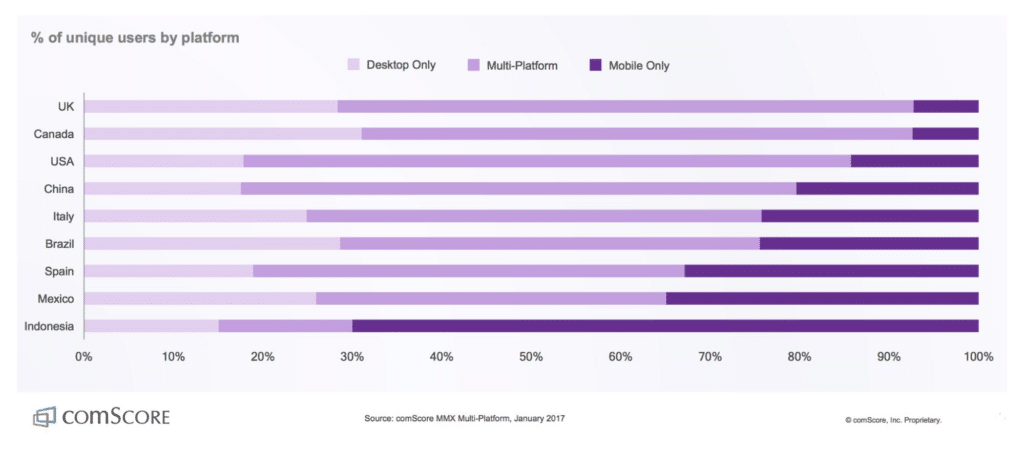Though overall time spent with digital media continues to increase, it’s hardly surprising that time spent on mobile platforms is exponentially rising—and that it shows no signs of slowing down. comScore reports that mobile now accounts for 69 percent of U.S. digital media time, and smartphone apps alone account for half of all digital time spent.
Given the increased time users are spending on these platforms, it’s also no surprise that mobile commerce is devouring a growing piece of the e-commerce pie. For example, Statista reports that U.S. mobile retail commerce is projected to grow from 34.5 percent of retail e-commerce sales in 2017 to 53.9 percent in 2021.
Based on this enormous growth, it’s clear that cross-channel tracking and cross-platform tracking need to be integral aspects of your attribution and measurement strategy in 2018. It’s undeniably important to measure revenue, transactions, and marketing events across channels with a highly disciplined approach, so you can extract data-driven insights that are as actionable as they are accurate. This is especially true for measuring partner contributions to conversions, as well as for paying partner commissions. Here are some key steps your brand can take to achieve this goal.
Note: This is a guest post written by Miriam Tremelling, Director of Marketing Strategy and Operations at Performance Horizon.
How to Implement Integrated Cross-channel, Cross-platform Measurement
Cross-channel, cross-platform measurement is a must for partner marketing. Consumer journeys now flow back and forth across platforms, such as mobile web and native app, and your partner marketing tracking needs to reflect that. Cross-channel, cross-platform measurement ensures that you can identify and pay commission on every relevant sale, not just those that occur on one device.
For partners, this means more revenue and better data for optimization. For brands, it means that partner marketers can demonstrate the full value of respective channels and platforms, and can rightfully gain credit for purchases that might erroneously be measured as organic conversions. It also means higher-quality customer insights that will power more effective cross-channel and cross-platform campaigns and programs.
With the Performance Horizon/Branch integration, for example, you can leverage Branch’s deep linking and attribution solutions to connect user activity across platforms at scale. By tracking and measuring your users like people instead of cookies, you’ll replace legacy (last-touch) attribution with a full view of all the various channels and platforms shared between your users and your brand. In effect, you’ll be able to more clearly, efficiently, and accurately determine which channels and platforms are actually leading to installs and conversions down the stream that are currently appearing as “organic”. From there, the data can power reporting and optimization in the Performance Horizon platform, closing the loop on person-based marketing and measurement.
For better or for worse, 2018’s mobile ecosystem is both cross-platform and cross-channel—ensuring that your partner and affiliate marketing strategies account for this trend is nothing short of essential.
How to Ensure Accurate Tracking of Customer Journeys that Include Apps
Apps are rapidly changing the retail commerce landscape. In the US, for example, 68 percent of online shoppers used a retailer’s mobile app, and 65 percent clicked on a retailer’s ad prior to visiting their online store. Consumers should be able to move seamlessly through these experiences, with each optimized to the device they are using.
A key reason why we co-created the Performance Horizon/Branch integration was to empower brands to track and measure customer journeys that include app visits. This is critically important because mobile app users tend to be the most loyal, committed, and frequent customers, and because, as seen in the below graph provided by comScore, user journeys are increasingly cross-channel and cross-platform. Data shows that AOV tends to be more than twice as high for app users when compared to mobile web consumers.
Without an app friendly tracking methodology, visibility into consumer app behavior is problematic to collect. The traditional method of partner measurement — pixel tagging — is relatively ineffective in apps, especially in iOS.
Better tracking throughout customer journeys can also lead to better customer experiences. If shoppers can continue their journeys easily between channels and across platforms, they are more likely to convert. There are strategies mobile experts are using today — such as enabling users to text themselves links they find on desktop or to see personalized content when transitioning from desktop site to mobile app — that can vastly improve customer experience and retention.
How to Utilize Deep Linking and Deferred Deep Linking for Higher Conversion Rates
It’s common knowledge that the fewer steps it takes to get someone to the item or offer they want, the more likely they are to convert. With deep linking, when an app user clicks an app link, they can be automatically redirected to the exact page in the app that features the item they want. Tracking and reporting purchases resulting from this is an added benefit for both the partner marketer and the referring partner.
With a deferred deep linking capability, people who don’t have an app yet can first be directed to the right app store to download the app, and then be automatically redirected to the right content in the app. Branch is a long-standing, premier provider of deep linking and deferred deep linking to deliver these benefits, but remains the only such provider to also offer sophisticated people-based insights and unified, cross-channel visibility into the full impact of all your marketing activities.
Deep links can be deployed across any marketing mix, including banner ads, video, email campaigns, and partner marketing activity. These tactics help brands and partners see their true marketing impact on any customer journey that involves these forms of media.
How to Integrate a Complete Set of Partner Data into Your Attribution Systems
With the explosion of m-commerce transactions, the ability to capture and integrate a comprehensive set of performance data across all channels and platforms has become essential. You need a solution that can facilitate seamlessly incorporating partner marketing data into multi-touch attribution modeling. For example, with the Performance Horizon/Branch integration, it’s easy to collect all of the necessary data and then process it to deliver the essential measurement and insights for a given channel. To begin, Branch’s attribution engine provides compelling user data that far outperforms legacy attribution providers’ point-in-time modeling and cookie-based attribution strategies in terms of both accuracy and usefulness. Performance Horizon’s APIs also enable you to deliver partner marketing data to a data warehouse and attribution platform, allowing information to be united into a single source of truth.
These advanced capabilities help marketers measure across the full suite of channels and partners that they use to engage customers. By leveraging these tools, you can understand the true role of partner marketing in all customer journeys—not just conversions attributed to the channel. No longer will partner contributions to incremental sales be questioned.
How to Optimize Partner Marketing with Cross-platform Attribution
Measurement and tracking across platforms is clearly integral to success in 2018’s mobile world. Consider leveraging the Performance Horizon/Branch integration to access deep, granular, real-time data for detailed measurement, contribution analysis, and best-in-class attribution.
If you are not yet using a universal linking platform or partner marketing platform, it makes sense to review your options and get engaged quickly. For more information, schedule a time to chat with Branch, or reach out to Performance Horizon for more information.























